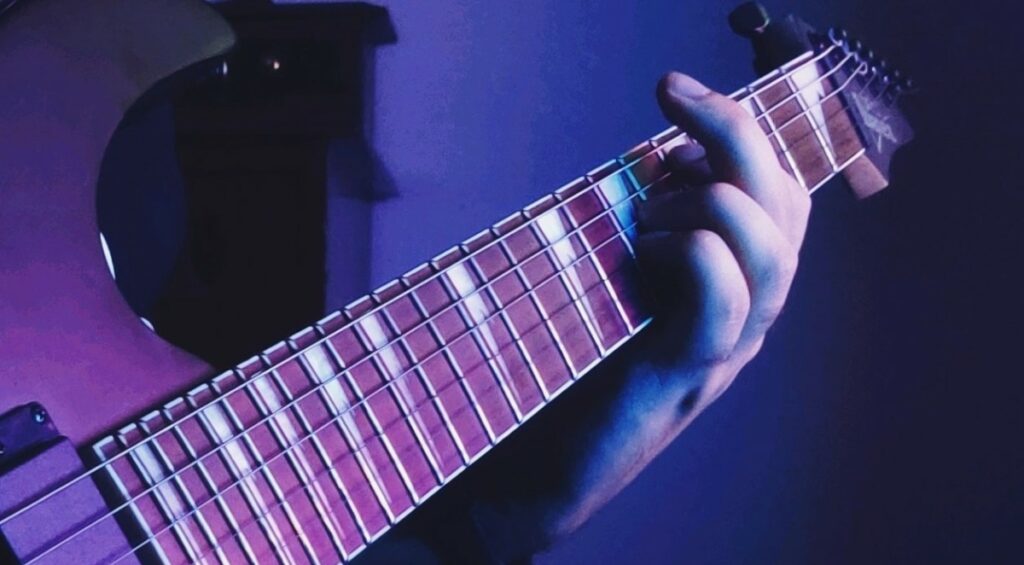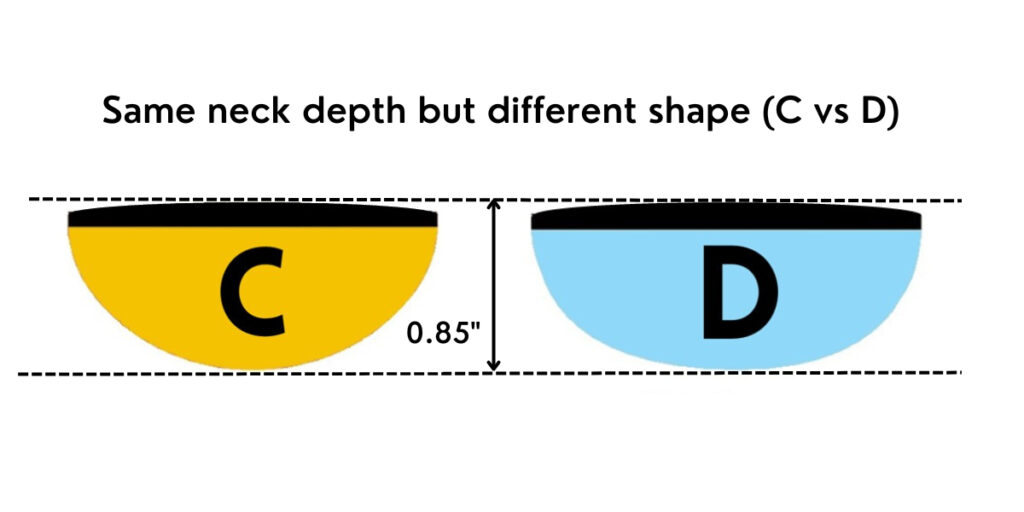Whether you have smaller hands, love to shred, or just prefer the feeling of a thinner guitar neck, you’ll find something suitable for you in this list of the electric guitars with thin necks.
What is a Thin Electric Guitar Neck?
Electric guitar necks typically measure between 0.8″ and 0.95″ thick at the 1st fret, and between 0.85 and 1.0″ at the 12th fret. Any electric guitar with a neck depth of less than 0.80″ at the 1st fret and 0.85″ at the 12th fret is considered a very thin neck.
Contents:
- List of Electric Guitars with the Thin Necks
- Thinnest Neck Profiles from Different Manufacturers
- Fender and Squier
- Gibson and Epiphone
- PRS
- Ibanez
- ESP
- Schecter
- Should You Choose a Thin Neck?
- The Importance of Neck Shape

Electric Guitars with Thin Guitar Necks
Here is a table of electric guitars by popular manufacturers with very thin necks. The table lists the neck profile name, along with the thickness of the neck at the 1st and 12th fret.
| Electric Guitar | Profile Name | 1st Fret Depth | 12th Fret Depth |
| Ibanez RG Prestige | Ibanez Super Wizard | 0.67″ | 0.75″ |
| Schecter Banshee | Schecter Ultra Thin-U | 0.75” | 0.79” |
| Schecter Reaper | Schecter Ultra Thin-C | 0.75” | 0.79” |
| Ibanez RG Premium | Ibanez Wizard III | 0.75″ | 0.83″ |
| ESP LTD M | ESP Extra Thin U | 0.75” | 0.83” |
| Charvel DK24 | Charvel Speed Neck | 0.77″ | 0.83″ |
| Jackson Dinky | Jackson Dinky | 0.78″ | 0.83″ |
| EVH 5150 Standard | Modified C | 0.79″ | 0.81″ |
| EVH Striped Frankie | EVH Backshape | 0.79″ | 0.825″ |
| Jackson Soloist | Speed Neck | 0.79″ | 0.85″ |
| ESP Eclipse | ESP Thin-U | 0.79” | 0.87” |
| Schecter Sun Valley | Schecter Thin U | 0.79″ | 0.87″ |
Please keep in mind that the measurements listed above are averages. It is not uncommon for guitars which have the exact same neck profile listed in the specifications, to have slightly different thicknesses in reality (usually by 0.01″-0.02″).
Thinnest Necks from Popular Manufacturers
In this next section I’ll be discussing the thinnest neck profiles (and which models have them) from the following electric guitar manufacturers:
- Fender and Squier
- Gibson and Epiphone
- PRS
- Ibanez
- ESP
- Schecter
Fender and Squier
The Fender electric guitars with the thinnest necks are in the American Ultra/ American Ultra Luxe series and measure 0.82″ thick at the 1st fret and 0.87″ thick at the 12th fret and have a Modern D-profile.
This “modern D” shape is slightly thinner than the “modern C” shape which measures 0.83″ thick at the 1st fret and 0.91″ thick at the 12th fret. Guitars with this “Modern C” neck profile include all Squier, Fender Player and Fender American Performer models.
Check out my in-depth guide on Fender neck profiles to learn more.

Gibson and Epiphone
The Gibson and Epiphone electric guitars with the thinnest necks have a “slim taper” neck profile which measures 0.82″ thick at the 1st fret and 0.93″ thick at the 12th fret. Guitar models with this “slim taper” neck include:
- Epiphone Les Paul Custom
- Epiphone Les Paul Standard ’60s
- Epiphone Les Paul Power Players
- Epiphone Les Paul Studio
- Epiphone Les Paul Classic
- Epiphone Les Paul Melody Makes
- Epiphone SG Standard
- Epiphone SG Special
- Epiphone SG Custom
- Epiphone SG Power Players
- Epiphone SG Classic
- Epiphone Explorer
- Epiphone Flying V
- Epiphone Firebird
- Gibson Les Paul Standard ’60s
- Gibson Les Paul Modern
- Gibson Les Paul Classic
- Gibson Les Paul Studio
- Gibson SG Standard ’61
- Gibson SG Special
- Gibson SG Junior
- Gibson Explorer
- Gibson Flying V
- Gibson Firebird
Check out my complete guide to Gibson neck profiles to learn more.

PRS
The PRS electric guitars with the thinnest necks is the Custom 24. The thinnest neck profiles offered by PRS is the “Pattern Thin” profile is used on the USA models and measures 0.83″ thick at the 1st fret and 0.89″ thick at the 12th fret.
If you are interested in a more affordable PRS SE model, the thinnest neck available is the “Wide Thin” which measures 0.81″ thick at the 1st fret and 0.89″ thick at the 12th fret. This is found on the PRS SE Custom 24 model.
Check out this guide to PRS neck profiles to learn more.

Ibanez
Ibanez guitars with a Wizard neck profile have very thin necks which measure 0.67″-0.75″ at the 1st fret and 0.752″-0.83″ at the 12th fret. Most Ibanez electric guitars have a wizard neck profile including RG models and S series models.
There are several different versions of the Ibanez Wizard neck profile which all have slightly different measurements. The most common are the Super Wizard and Wizard IIII:
- The Ibanez Super Wizard neck measures 0.67″ thick at the 1st fret and 0.75″ thick at the 12th fret. It is found on most RG Prestige models.
- The Ibanez Wizard III neck measures 0.75″ thick at the 1st fret and 0.83″ thick at the 12th fret. It is found on RG Premium models.
Check out my complete guide to the different Ibanez Wizard neck profiles to learn more.

ESP
ESP guitars with the thinnest necks have an “thin-U” neck profile which measures 0.79″ thick at the 1st fret and 0.87″ thick at the 12th fret. The ESP Thin-U style neck is seen on many ESP/ LTD 6-string models such as the E-II. Although this neck profile is still definitely on the thin side, it’s not as thin as something like an Ibanez Wizard or Schecter Ultra-Thin U.
The “thin U” neck is on most ESP guitars including:
- ESP E-II Arrow Series
- ESP E-II Eclipse
- ESP E-II EX Series
- ESP E-II FRX Series
- ESP E-II Horizon Series
- ESP E-II M Series
- ESP E-II SN Series
- ESP E-II TE Series
- ESP E-II Viper Series
- ESP Original Arrow Series
- EPS Original Eclipse Series
- ESP Original Horizon Series ESP
- Original Mystique Series
- ESP LTD 1000 Series
- ESP LTD EX Series
- ESP LTD H Series
- ESP LTD Phoenix Series
- ESP LTD SN Series
- ESP LTD TE Series
- ESP LTD Viper Series
ESP LTD make a slightly thinner neck called the “Extra Thin U” which measures 0.75″ thick at the 1st fret and 0.83″ thick at the 12th fret. This neck can be found on the following models in the LTD range:
- ’87 Series
- Arrow Series
- M Series

Schecter
Schecter electric guitars with the thinnest necks have either an “Ultra Thin-C” or “Ultra Thin-U” neck profile which measures 0.75″ thick at the 1st fret and 0.79″ thick at the 12th fret. The Schecter Banshee models have the Ultra Thin-U neck, and Reaper models have the Ultra Thin C-neck.
Although both profiles have the same depth measurements the thin-C has shallower shoulders compared to the thin-U which feels fuller due to those more broad shoulders.
These ultra-thin necks are not to be confused with other profiles offered by Schecter which include the “Thin C” which is thicker and measures 0.79″ thick at the 1st fret and 0.87″ thick at the 12th fret. Most Schecter guitars actually have this Thin-C profile instead of the Ultra-Thin C/ U necks.

Should You Choose a Guitar with a Thin Neck?
Thin necks typically suit guitarists with either smaller hands, or those who like to shred as a shallower neck depth typically makes it easier to perform single note runs very quickly. Beginners also usually find guitars with thinner necks easier to play.
However, there are some players who will find thinner necks uncomfortable as they do not provide as much support and are more likely to cause hand cramping particularly when playing open and barre chords, hence why they are less popular for rhythm guitar playing.
Check out my comparison of the pros and cons of thick and thin guitar necks to learn more.
I’d highly recommend you try a range of electric guitar necks in your local store before purchasing anything. The depth of the neck massively affects how the instrument feels to play. Do not assume that an ultra-thin neck will be the right option for you if you love to shred, or just have smaller than average hands as it is not always the case. It’s always best to try before you buy.
Make Sure You Also Consider the Shape
Neck thickness is not the only factor to consider. You should also factor in the shape of the neck, as this massively affects how the guitar feels to play as well.
There are four main neck shapes:
- C
- D
- V
- U

The depth or thickness of a guitar neck that we’ve discussed in this article is only a measurement of the the thickest point of the neck which only tells part of the story. Check out this diagram.

As you can see, these two necks have the same depth (0.85″), but a different shape. The D-shape neck has broader shoulders compared to the C-shape neck, which means it feels fuller in the hand despite having the same thickness.
This is why it’s very important to consider the shape as well as the depth/ thickness of the neck.
Check out my complete guide to the different guitar neck shapes
Here are some more articles you might find useful:
